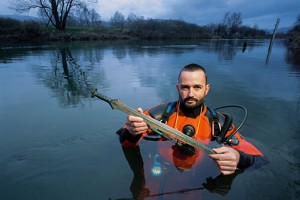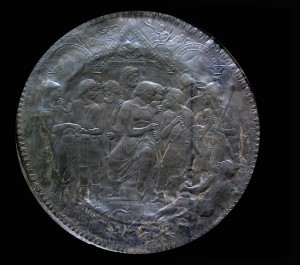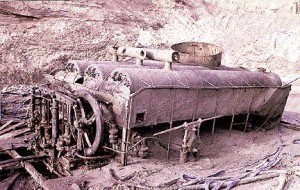Pulling Things Out of Rivers March 13, 2012
Author: Beach Combing | in : Ancient, Contemporary, Medieval, Modern , trackbackRivers are useful guardians of the past: often thousands of years roll by (and millions of tonnes of water) before things that have been thrown in are fished out (sometimes literally) several hundred or thousands of years later. Here are Beachcombing’s favourite they-were-found-in-river things. Others would be welcome: drbeachcombing AT yahoo DOT com
1) Claudius’ Head in the Alde: In 1907 a school boy pulled this prize out of the river and brought it to a local antiquary. From then excitement slowly mounted and it has never entirely died down. What is of particular interest is the way that the head of the emperor Claudius seems to have been hacked off a statue and a blow to the back of the head suggests that murder was done on an inanimate object. It looks very much as if a Roman statue was ritually slaughtered and the head was then dedicated to a Celtic river God (i.e. thrown in a river): back in the days when the Alde was called the Itchen. And the suspects? Why not Boudicca’s revolt in 61 AD when Colchester with its Temple of Claudius was overrun by British ‘savages’ and Rome was, at least for a season, lain low in East Anglia?
2) Silver Plate in the Rhone: ‘In 1656 a fisherman on the banks of the Rhone, in the neighbourhood of Avignon, drew to shore in his net a round substance in the shape of a large plate, thickly encrusted with a coat of hardened mud. A silversmith who happened to be present brought it for a trifling sum. He took it home, and upon cleaning and polishing it, found it to consist of pure silver… Fearing that such a massive and valuable piece of plate might awaken suspicion , if offered for sale entire, he divided it into four equal parts, each of which he disposed of at different times and places.’ One of the pieces was sold at Lyons to Mr. Mey, a wealthy and well-educated merchant, who at once saw its value and who, after great effort, procured the other three sections. He had them nicely rejoined, and the treasure was finally placed in the cabinet of the King of France.’ This object is often called Scipio’s Shield. It actually dates to the fourth century AD.
3) A Steamboat in the Missouri River: In 1987 a nineteenth-century steamboat, the Arabia was discovered in a field just off the Missouri. Its excavation proved logistically difficult because river waters kept pouring in as the excavators dug down. In fact, in one episode an excavator was almost killed. The boat had disappeared into the mud of that river almost a hundred and fifty years before, sinking in ten minutes with no casualties save a mule! 700 items are now on display from this victim of ‘the hungriest of all rivers’ at a special Arabia museum: and the boat stands as one of the most impressive archaeological finds from frontier America.
4) A Tank and the Neva. This picture shows a BT-5 one of the most impressive Soviet tanks from WW2 being fished out of the river. A nice question is how it got there! Images of the tank and descriptions of the find suggest that there was no one in it when it went down into its watery grave – so bridges and vodka-sozzled drivers have to be ruled out. And it does not seem to have suffered any damage from the enemy: though Soviet tanks were famously resistant to even point blank blasts. Perhaps its owners, as they were surrounded by the Germans decided to get rid of it and the nearby river offered the quickest way to dispose of their hardware?
5) Hindu finds from the Thames: The Thames has been good for ‘Roman brooches, medieval pilgrim badges, 17th-century tin-glazed tiles, an 18th-century miniature portrait and an early-20th century handgun‘. But for Beachcombing at least some of the most curious finds have been the various Hindu statuettes dredged up in London’s river. So what does this represent: an underground Hindu cult in medieval London? Not a bit of it. The best estimates put these objects from the 1880s to 2000. For London’s modern Hindu community have evidently been using the Thames as a kind of surrogate Ganges, a place to throw their gods in an eerie echo of those rituals carried out in pre-Christian times on the banks of the same waterway. The British Museum at first thought that some of these statues were Roman… An understandable if entertaining mistake.
***
14/Mar/2012: First is Louis with some corrections for the tank story. ‘Actually BT tanks were notorious for their thin armor, which became very clear during the Winter War and the Nomohan incident and which prompted the Red Army to change to the T34 faster then previously scheduled. And, the tank was probably on its way to the Neva Bridgehead, on a pontoon, during a relief offensive for Leningrad, as can be read in this English language website: Second is Tacitus from Detritus: Here is a link to one of my favorite river finds. An early confederate submarine of which no reliable record has ever been produced. Dredged up by accident in 1878. Technically found in a bayou coming off of Lake Ponchartain, but clearly designed for use against an impending Union attack on New Orleans. Even the thought of entering the treacherous muddy waters of the Mississippi in this glorified tin can alarms me! Then Jakub: ‘How about the opposite: pulling boats out of the ground? This happened a few years ago not far south from Warsaw, Poland. In a pond in an apple orchard a 500-year old ship was found and dug out: a 34m-long grain-punt. 500 years earlier Vistula, which is notorious for changing its course (and thus a most unsuitable container for long-lost artefacts), flowed through what is now the apple orchard on the border of a place called Czersk – once the capital of an entire province, dwindled into a tiny village once the river that gave it its prosperity decided to pack up and move a few miles eastward, leaving boats like this one in the middle of a sandy plain (link in Polish). Next is Invisible: My personal favourite [creepy warning!]: I visited the Steamboat Arabia museum a couple of years ago. The amount of organic materials – leather, cloth, foodstuffs – that survived is simply astounding. Apparently the sites of several other wrecked steamboats buried by the shifting river are known and await excavation. The remarkable thing about the Arabia excavation and museum is that it was done entirely without public funds – the Hawley family (with friends and supporters) paid for the arduous, large-scale excavation, the conservation of the artifacts, and the museum out of their own pockets. The book The Treasures of the Steamboat Arabia by David Hawley gives a step-by-step account of the difficulties involved in getting the steamboat and its cargo out of the tons of mud that covered it and includes color photos of many artifacts. An extraordinary story.’ Thanks Louis, Tacitus, Invisibile and Jakub!!
16 March: Some great stuff from Jim W here. ‘Similar to the Arabia steamboat recovery was the USS Cairo sunk in the Yazoo River during the Vicksburg Siege of the US Civil War. Found by old-style geophysics (magnetic dip needle) nearly intact but broken in half during recovery. Massively displayed in National Military Park as half original and half reconstructed. Museum contains quantities of personal and military gear recovered in very good state of preservation. On the other side, the CSS Arkansas is still buried under a mainline levee near Sunrise, LA. She was badly damaged during the Vicksburg Siege and escaped downriver to her coup de gras at Baton Rouge. Steamer Desoto discovered under a bean field near Missouri River, IA, again by 1960s vintage geophysics (flux-gate magnetometer). Excavated and on display with large quantity of personal and trade goods. Carried supplies and equipment to Montana gold rush before snagged. Meandering, large-flow, high sediment rivers like the Mississippi/Missouri system do this kind of thing as a matter of course, generally leaving the wrecks hundreds of yards to miles from the present courses in old meanders. Reference the Mississippi Confederate submarine: The Grand Gulf State Park Museum, Port Gibson, MS has (or had several years ago) a submersible home-built from an old boiler that was supposedly used for bootlegging from Louisiana to Mississippi back in the good/bad old days of Prohibition.’ Thanks Jim!!!!
28 March 2012: Norman writes: Haven’t had any luck tracking an image of it down yet (still working on it), but I remember once seeing a crucifix in a museum in New Brunswick (Canada) that had been recovered from a river. It was made of bone (or maybe ivory, I misremember), and was of the type that missionaries would give out to the local Indians (in this case either Mi’kmaq or Maliseet). The cool thing about it was that the wrists and ankles of the figure, where they were attached to the cross, had been scraped so thin that they had nearly snapped off. Archaeologists conjectured that the natives had scraped thin shavings of the figurine into a broth which would then be fed to sick people – apparently a conflation of religion and magic, or perhaps a misunderstood interpretation of the old “this is my body…” routine that the indians took literally.’ thanks Norman!!
20 Dec 2014: James Open writes, ‘You seem to have missed this one from mid September, ‘NANJING, CHINA—Eleven-year-old Yang Junxi was playing near the Laozhoulin River in east China’s Jiangsu Province when he found a bronze sword in the sediments. His father contacted the Gaoyou Cultural Relics Bureau where it was identified as a 3,000-year-old artifact from the time of the Shang and Zhou dynasties. “The short sword seems a status symbol of a civil official. It has both decorative and practical functions, but is not in the shape of a sword for military officers,” Lyu Zhiwei, head of the bureau, told Xinhua News. The river had been recently dredged, which may have brought the artifact to the surface. Archaeological investigation of the river and surrounding area is planned.’ Did the lady of the lake lift her hand to receive the steel?’ Thanks JO








